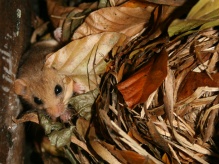Dormouse Surveys
Dormice are a European Protected Species and therefore a licence is required to undertake surveys that will disturb them.
Dormice live at low numbers and have undergone a dramatic decline over the last century due to changes in woodland and hedge management and the fragmentation of their habitat. As they are mainly nocturnal and spend most of their active time in trees, hedgerows and scrub they are hard to observe, therefore a number of survey methods have been developed.
The first is Hazel nut searches in autumn and early winter, as Dormice open Hazel nuts in a distinctive way. This survey method does not require a licence, but can only be used to prove presence, not likely absence. However, this is of no use if Hazel trees are not present on a site or do not fruit in a particular year.
The two other main forms of survey are tube and box surveys, both providing artificial nesting sites to encourage Dormice to use them and therefore be found more easily than natural nest sites, which are rarely found. Both can only be used when Dormice are active, from April to November and require a handling licence. Tubes are designed for use in hedgerows and scrub, while boxes are used in woodland.
European Protected Species (EPS) licence applications require good survey data to base the mitigation measures on and we have the sound understanding of Dormice ecology that is needed for a successful application. As EPS licence applications take 30 working days to be determined it is important to begin these surveys early if Dormice are likely to be present on-site.
View some examples of our Dormouse Survey projects >
If you have any questions or would like more information on the above, please call Principal Ecologist Mark Satinet on 01993 864 958 or email info@4acreecology.co.uk.

